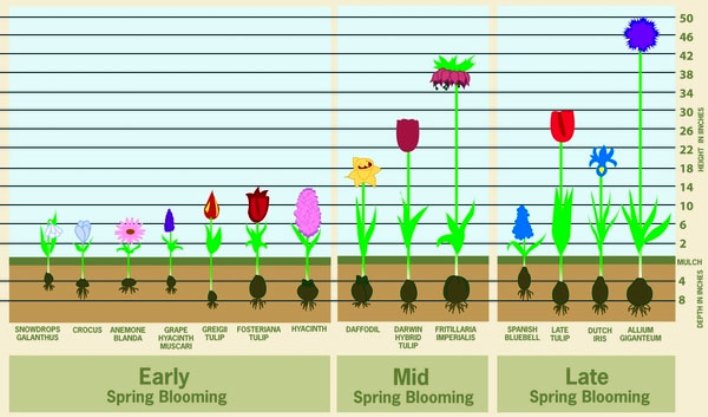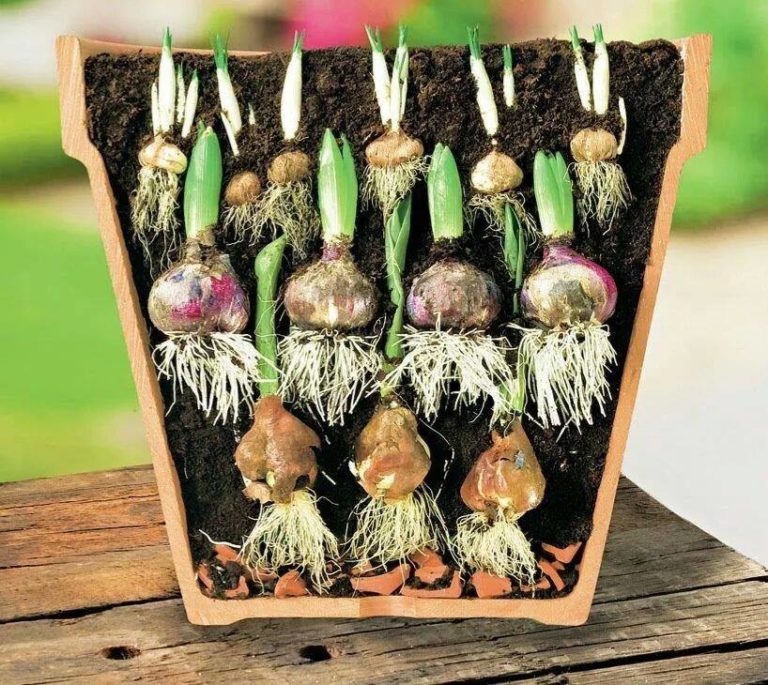FOR SPRING COLOR, BULBS MUST BE PLANTED IN THE FALL
Nothing is more satisfying than planting dormant brown bulbs in autumn and seeing them emerge in late winter or early spring with fresh green shoots and gorgeous fresh flowers.
Follow these steps to beautiful spring color:
Purchasing:
- Purchase bulbs in late September and October when the selection is best.
- Plan your beds. Plant bright colors (yellows, oranges, and whites) to the outside to enlarge the overall appearance of your beds.
- Plant Tulips, Hyacinth, and Daffodils in groups of 15 to 25 bulbs. This will provide stability against the wind and a better “drive by appearance.”
- To extend bloom times plant early, mid and late blooming varieties together. Look on the packages or box pictures for bloom times.
- When purchasing, make note of bloom heights…you wouldn’t want to plant taller varieties in front of shorter varieties.
- Plant fragrant varieties by your front entrance to provide a nice fragrance for guests.
- Fall is the time to plant garlic for a summer harvest.
- Fall is also the time to plant Bearded Iris rhizomes. They are best planted in September or early October. Plant rhizomes about soil level. Leave a very small amount of the rhizome above the soil and then water in thoroughly.
Storage:
- Tulips and Hyacinth need 6-7 weeks of cooling prior to planting. After purchase, place bulbs in well ventilated bags and place in your fridge. Keep away from ripening fruit. Planting time should be around mid-Dec. so place in fridge mid-Oct. to 1st of Nov.
- Place in a cool dry place before pre-cooling; avoid storing bulbs in full sun. Heat is a bulb’s worst enemy.
- Irregular scars and even small amounts of Penicillin won’t damage bulbs. Plant only firm bulbs.
- Daffodils and other smaller bulbs don’t require cooling to bloom, but 3-4 weeks will enhance the overall planting, and will not hurt them.
- Extended cooling won’t hurt the bulbs. If you’re late planting, plant anyway. Although mid-December is optimum, plantings in mid-January will still come up and bloom.
Planting:
- General rule is to plant bulbs at a depth equal to 2.5 times their width. Example: For 2″ wide bulbs, the hole you dig to place bulbs in should be 5″ deep.
- Plant in well drained areas; raised beds are great, so are large containers.
- To ensure the success of your bulbs, plant in good soil that is rich with organic matter. Amend clay soil with compost and expanded shale. Expanded shale aerates the clay soil, makes it easier to work, and improves drainage. Add these amendments separately or use a premixed product such as Covington’s Soil Builder.
- Space Tulips, Hyacinth, Daffodils on approximately 5” centers; smaller bulbs on 1-2” centers.
- Heat and wind have a direct impact on bloom length. Pick an area that is protected from afternoon sun with some wind protection to get optimum bloom length. If that is impossible, don’t let it deter you. You can still have a great bulb showing.
- My suggestion is to dig up the entire area you are planting a couple of inches deeper than required. Fill in to the required planting depth, place the bulbs in the area, and cover to ground level. DIG, DROP, DONE!
- Fertilize with Hi-Yield Bone & Blood Meal or Covington’s Premium Flower & Garden Fertilizer per instructions. Water in, and wait for your spring bulb show. If the winter is dry, water occasionally. Beware of overwatering.
Traditional Bloom Time:
Tulips Early Bloomers–Single Early and Double Early, Fosteriana, Kaufmannian (N/A in Texas due to heat)
Tulips Mid Bloomers–Darwin Hybrids, Triumphs, Gregii, Species
Tulips Late Bloomers—Single late, Parrot type, Bouquet, Double Late, Lily Flowering & Fringed
Daffodils–Read the package, they’re all over the board
Hyacinths—Early
Names to Remember:
Muscari Mountain Lady Tulip TopFlame Tulip Come As You Are
Tulip Purissima Blonde Narcissus Akita Tulip Smooth Sailing
Tulip Lily Flowering Mix Narcissus Holland Sensation Daffodil Double Trouble
Tulip Texas Flame Iris Dwarf Halkis Tulip Summer Soiree
PLANTING CHART
The chart below provides general guidelines for the proper planting depth of your bulbs. Refer to the package or tear-off tag for variety specific information.

Bulb Lasagna Recipe (Double or Triple Decker Bulb Planting)

Making bulb lasagna is much like making an edible lasagna…..it’s a matter of layering all of your ingredients. Different bulbs bloom at different times in the Spring, so by planting them all in the same container in the Fall, you’ll get a Spring’s worth of successive blooming flowers.
Here’s how it’s done (check package for bloom times):
Step 1 – Cover the bottom of your large container with a layer of gravel for drainage, then add soil.
Step 2 – On top of that place a full layer of large, late-Spring bulbs such as tulips & daffodils.
Step 3 – Cover them with another 3” layer of soil, then place a full layer of medium sized, mid-Spring bulbs such as tulips, hyacinth & daffodils.
Step 4 – Cover them with another layer of soil, then place a full layer of small, early- Spring bulbs grape hyacinth & crocus.
Step 5 – Top it all off with one more 3” layer of soil, then cover the container with mulch and water well.
In early Spring, the top layer will bloom first, then around the time it’s dying off, the middle layer will come up, followed by the bottom layer.
Revised 10/19/18
